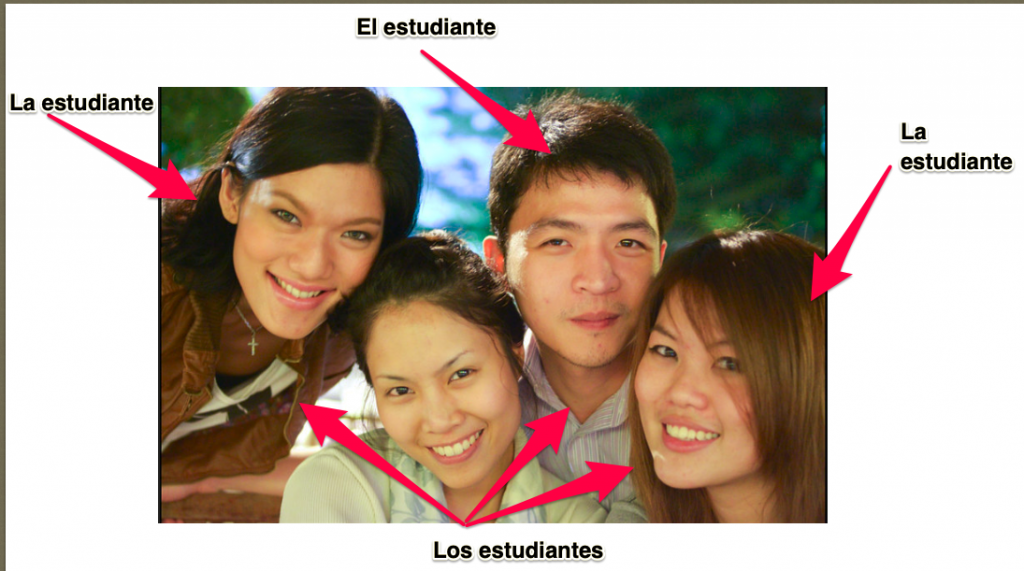Capítulo 1: Hola ¿Cómo estás?
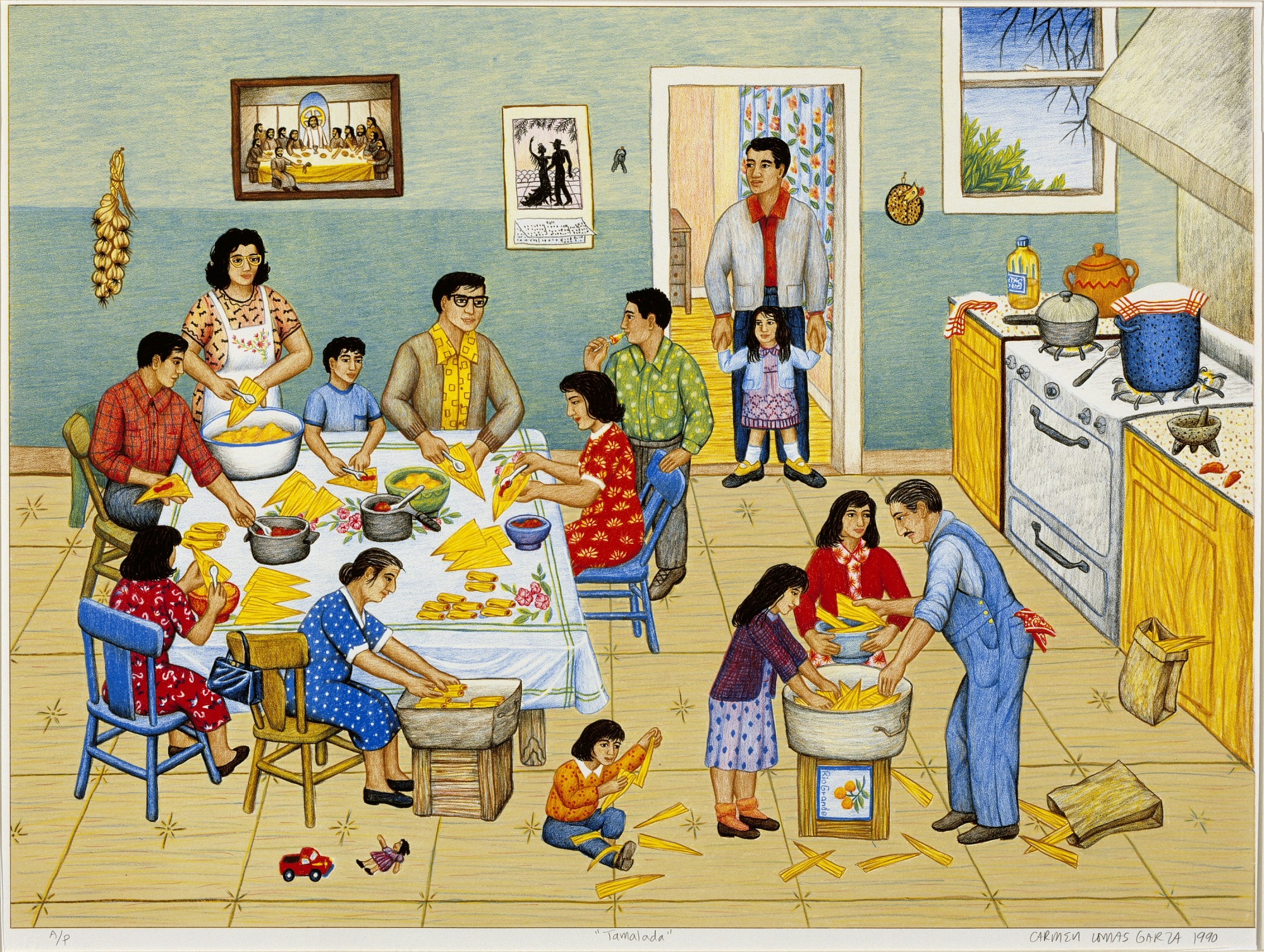
Tamalada, 1990 (Carmen Lomas Garza)
Sobre el artista: Carmen Lomas Garza is a Mexican-American artist and illustrator. Her famous paintings reflect the traditions and life of Mexican families. She wants to honor her heritage by drawing scenes from daily life and popular culture that represent the richness of Latino culture.
Learning Objectives
At the end of this chapter, students will be able to perform the following tasks in Spanish:
- I can greet people and say goodbye
- I can meet people and be polite
- I can count in Spanish
- I can exchange personal information (name and origin)
Vocabulario
Greetings and goodbyes / Courtesy Expressions / Introductions
Pronunciación
The alphabet
Mosaicos culturales
Las variaciones del español
Estructuras gramaticales
1.1 Spanish Articles
1.2 Nouns- Gender and Number
1.3 Numbers 0-100
1.4 Present tense of SER (BE verb)
Escritura
Composición 1: Información personal
Cultura
País: USA
Música: Selena
Personalidad: César Chávez
Lectura
The Culture of Greetings
Vocabulario: Hola, ¿Cómo estás?

| Los Saludos | Greeting People |
|---|---|
| Formal | |
| Buenos días | Good morning |
| Buenas tardes | Good afternoon |
| Buenas noches | Good evening |
| ¿Cómo está? | How are you? |
| ¿Cómo le va? | How are you? |
| Familiar | |
| Hola | Hello; hi |
| ¿Qué tal? | How are you?; How is it going? |
| ¿Qué hay de nuevo? | What’s new? |
| ¿Qué onda? | What´s up? |
| ¿Qué hubo? |
|

| Las despedidas | Farewell |
|---|---|
|
Goodbye |
| Buenas noches | Good night |
| Chao (chau) | Bye |
| Hasta luego | See you later |
| Hasta mañana | See you tomorrow |
| Hasta pronto | See you soon |
| Hasta la próxima | See you next |
| Hasta la vista | See you later |
| Nos vemos | See you |
| Que le vaya bien | Hope it goes well (fare thee well) |
| Saludos a… | Greetings to… (say hello to) |
| Expresiones de cortesía | Courtesy Expressions |
|---|---|
|
|
Thank you |
| Muchas gracias (Mil gracias) | Thank you very much |
| De nada (por nada) | You are welcome |
| No hay de qué | You’re welcome |
| Por favor (por fa) | Please |
| Permiso (con permiso) | Pardon me; excuse me |
| Lo siento | I am sorry |
| Perdón | Pardon me; excuse me |
| ¿Cómo está? | How are you? |
|---|---|
|
¿Cómo está usted? |
|
| ¿Cómo estás? | How are you? (fam.) |
| ¿Qué hay de nuevo? | What’s new? |
| ¿Qué pasa? | What’s happening?; What’s going on? |
| ¿Qué tal? | How are you?; How is it going? |
| (Muy) bien, gracias | (Very) well, thanks |
| Bastante bien | Pretty well |
| Nada | Nothing |
| No muy bien | Not very well |
| Regular | So-so; OK |
| Más o menos | So-so; OK |
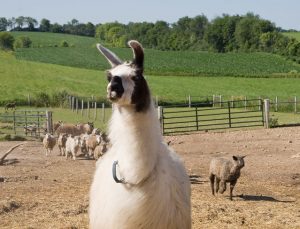
| Presentaciones | Introductions |
|---|---|
|
|
|
| ¿Cómo te llamas? | What’s your name? (fam.) |
| Me llamo… | My name is… |
| ¿Y tú? | And you? (fam.) |
| ¿Y usted? | And you? (form.) |
| Mucho gusto | Pleased to meet you |
| El gusto es mío | The pleasure is mine |
| Encantado/a | Delighted, Pleased to meet you |
| Igualmente |
Likewise |
| Es un placer | It´s a pleasure |
| Le presento a… | I would like to introduce you to (name). (form.) |
| Te presento a… | I would like to introduce you to (name). (fam.) |
| ¿De dónde es? | Where are you from? |
|---|---|
|
¿De dónde es usted? |
Where are you from? (formal) |
| ¿De dónde eres? | Where are you from? (familiar) |
| Soy de. . . | I am from . . . |
| Títulos / Titles
When speaking to someone in a formal situation, we use titles before last names: |
|
|---|---|
|
señor (Sr.) |
Mr.; sir |
| señora (Sra.) | Mrs.; ma´am |
| señorita (Srta.) | Miss |
| doctor (Dr.) | Doctor (male) |
| doctora (Dra.) | Doctor (female) |
| Licenciado | Dr. (graduate) |
| Licenciada | Dra. |
Don and doña are used with first names to show respect.
Don Pedro doña María
|
Sustantivos |
Nouns |
|---|---|
| La clase | class |
| La universidad | university |
| El cuaderno | notebook |
| El libro | book |
| El reloj | clock |
| El lápiz | pencil |
| El MAPA | map |
| El niño | little boy |
| La niña | little girl |
| El chico | boy |
| La chica | girl |
| El hombre | man |
| La mujer | woman |
| El profesor | professor (male) |
| La profesora | professor (female) |
| El estudiante | student (male) |
| La estudiante | student (female) |
| La casa | house |
| La mesa | table |
| La silla | chair |
|
Saludos, despedidas y expresiones de cortesía |
|---|
Can you tell the difference between formal and informal or familiar situations?
Situaciones formales

- María Martell: Buenos días, señor Ramirez.
Diego Ramirez: Buenos días, señora Martell, ¿Cómo está?
María Martell: Muy bien gracias, ¿Y usted?
Diego Ramirez: Bastante bien, gracias. Hasta luego.
María Martell: Adiós. - Lupe: Buenas tardes, profesor Banderas.
Antonio Banderas: Hola, ¿Cómo se llama usted, señorita?
Lupe: Me llamo Lupe García.
Antonio Banderas: Mucho gusto.
Lupe: Igualmente.
Antonio Banderas: ¿Y usted, de dónde es?
Lupe: Soy de México, ¿Y usted?
Antonio Banderas: De España. Nos vemos pronto Lupe.
Lupe: Sí profesor, Hasta luego.
Situaciones informales (familiares)
3. Carlos: Hola Patricia, ¿Qué tal?
Patricia: Hola Carlos, ¿Cómo estás?
Carlos: Muy bien, ¿Y tú?
Patricia: Más o menos. Nos vemos mañana, ¿sí?
Carlos: Bien. Nos vemos mañana. Adiós
Patricia: Chao.
4. Frida González: Hola, Me llamo Frida, ¿Y tú? ¿Cómo te llamas?
Pepe Flórez: Hola, Me llamo José, pero me puedes llamar Pepe (but you can call me Pepe).
Frida González: Encantada.
Pepe Flórez: Mucho gusto. ¿De dónde eres Frida?
Frida González: Soy de México, ¿Y tú?
Pepe Flórez: Yo soy de Chile.
Frida: ¡Qué bien!
ACTIVIDAD #1
Categorías. Saludos, despedidas y presentaciones. Write whether the following words and phrases are saludos (greetings), despedidas (farewells),
or presentaciones (introductions).
¡Inténtalo!
- ¿Cómo está usted?
- Mucho gusto
- Te presento a María
- Hasta mañana
- Buenas noches
- ¿Qué hay de nuevo?
ACTIVIDAD #2
Saludos y despedidas. Complete the following phrases with the appropriate expression from the given list.
Soy de España El gusto es mío Muy bien y ¿usted?
Nos vemos
- ¿Qué hay de nuevo?
- ¿Cómo te llamas?
- ¿Cómo está usted?
- Mucho gusto
- Adiós
- Muchas gracias
- ¿De dónde eres?
- Le presento a mi amigo Jorge
¡Inténtalo!
ACTIVIDAD #3
Completar. Work with a partner to complete the following dialogues.
Ejemplo:
Estudiante 1: Buenos días, profesora Ramirez.
Estudiante 2: Buenos días clase.
- Estudiante 1: Hola, ¿Qué tal?
Estudiante 2: - Estudiante 1 : ¿Cómo te llamas?
Estudiante 2: - Estudiante 1:
Estudiante 2: Soy de Colombia. - Estudiante 1:
Estudiante 2: Muy bien y ¿tú? - Estudiante 1: Hasta pronto
Estudiante 2:
ACTIVIDAD #4
Traducir. WRITE-PAIR-SHARE. Translate the following words into Spanish, then pair with a partner and compare your answers.
| See you! | |
| Excuse me | |
| How do you say…..? | |
|---|---|
| What is your name? | |
| Yes, of course! | |
| What´s up? | |
| My name is… | |
| How are you? | |
| Good morning | |
| Good afternoon |
ACTIVIDAD #5
Conversaciones. In groups of three, write five short conversations based on what the people in these pictures would say.
1

2
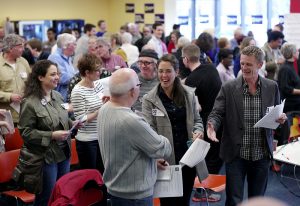
3
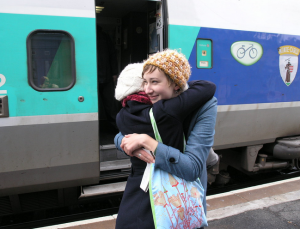
4

5

ACTIVIDAD #6
Situaciones. It is the first day of class, and you are very excited to meet your new classmates in your SPA class! You decide to get to know TWO students who are sitting next to you. With a big smile:
- Say hi and introduce yourself
- Ask him/her what his/her name is
- Tell him/her that you are pleased to meet them
- Ask them where they are from?
- Say goodbye
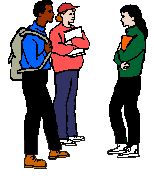
Pronunciación
The Spanish Alphabet – El Alfabeto (ABCdario)
There are 27 letters in the Spanish alphabet, including “ñ” and “rr.” All the letters are pronounced with the exception of the letter “h,” which is silent before any vowel but is pronounced when accompanying the letter “Ch.”
| Letra | Nombre | Ejemplo | Pronunciación |
|---|---|---|---|
| A | a | Agua | Ah |
| B | be | Bien | |
| C | ce | Casa, cinco | C + a, o, u (strong sound) = “k” C + e, i (soft sound) = “s” |
| D | de | Días, perdón | “D” sound is soft between two vowels |
| E | e | Encantada | “eyh” |
| F | efe | Filosofía | |
| G | ge | Geografía, gusta | G + a, o, u (strong sound) =”guh” G + e, i (soft sound) =”huh” |
| H | hache | Hola | The h is SILENT (unless it is a ch) |
| I | i | Idioma, inglés | “ee” sound |
| J | jota | Jalapeño | It makes the same sound as the English “H.” |
| K | ka | Kilo | |
| L | ele | Luego | |
| LL | elle | Me llamo | Double L makes a “Y” sound |
| M | eme | Mesa | |
| N | ene | Nada | |
| Ñ | eñe | Español | It makes the sound that you hear in “onion.” |
| O | o | Otoño | |
| P | pe | Permiso | |
| Q | qu | Queso | “Q” — which always appears in combination with the letter “u” — is pronounced like the “k” in the word “kid.” |
| R, RR | ere, erre | Pero, perro, Rosa | “r” sounds like the “dd” in words like “ladder.” When the “r” is the first letter of the word, it is trilled like the “RR” |
| S | ese | Saludes | |
| T | te | Tengo | |
| U | u | Universidad | “oo” sounds like “boo” |
| V | ve | Vamos | “B” sound, in some countries, is a little softer |
| W | doble u, doble ve | Wilson | |
| X | equis | Examen | “KS” sound, like “ek-samen” |
| Y | i griega, ye | Yo | |
| Z | zeta | Zapatos | “S” sound (except in Spain -th-) |
| The Spanish Vowels: Las vocales |
|---|
| It is helpful to pronounce each vowel well. There is only one way to pronounce them.
A- ah E- eyh I- ee O- o U- oo |
ACTIVIDAD #1
Please read out loud the following words, paying special attention to the vocalic sounds and stress. In case there is a written accent over the vowel, place more emphasis on that syllable:
| clase | español | universidad | cuaderno | niño hombre |
| buenas | libro | computador | José | Estados Unidos |
|---|---|---|---|---|
| hospital | perro | pero | nada | agua acá |
ACTIVIDAD #2
¿Cómo se escribe? Work with a partner and take turns to ask how to spell each other’s names.
| Pablo Neruda ⇑ ⇑ nombre apellidoSe escribe: pe-a-be-ele-oSe escribe: ene-e-ere-u-de-a |
|---|
Example:
E1: ¿Cómo se escribe tu (your) nombre?
E2: Se escribe _____________________
E1: Y (and) ¿cómo se escribe tu apellido?
E2: Se escribe _____________________.
E1: Perdón, ¿puede repetir, por favor?
E2: se escribe ______________________.
ACTIVIDAD #3
APODOS. Here are the most common Spanish nicknames. Can you match them with the first name? Guess as many as possible before you check with a classmate or the internet.
| 1. | Antonio | a. Paco |
| 2. | Ignacio | b. Fonsi |
|---|---|---|
| 3. | Alejandro | c. Toño |
| 4. | Mercedes | d. Chayo |
| 5. | Alberto | e. Chuy |
| 6. | Guillermo | f. Alejo |
| 7. | José | g. Memo |
| 8. | Rosario | h. Merche |
| 9. | Francisco | i. Beto |
| 10. | Jesús | j. Pepe |
| 11. | Guadalupe | k. Nacho |
| 12. | Alfonso | l. Lupe |
Nicknames
In the Spanish-speaking world, nicknames can sometimes seem harsh or even offensive. It is not offensive (generally) to refer to someone based on a physical characteristic.
For example,
Flaco, flaca, gorda, gordo, guero, guera, pelón, viejo.
ACTIVIDAD #4
La geografía. Fill in the blanks with the missing letter from the Latin American countries below. Then spell it out.
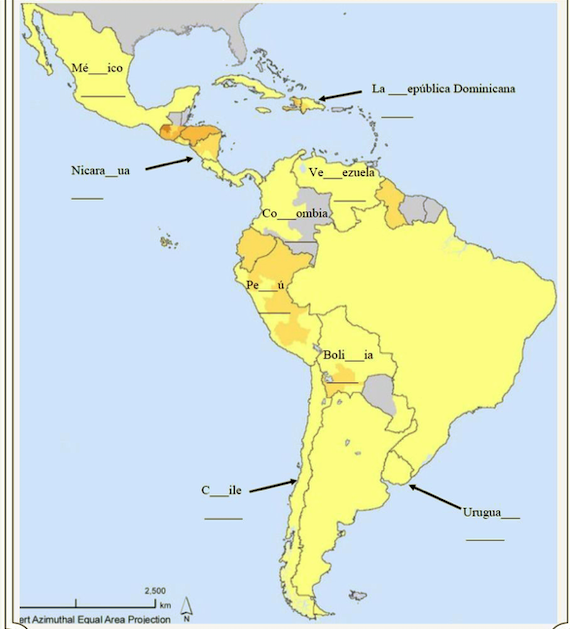
La __epública Dominicana
Nicara__ua
Ve__ezuela
Co__ombia
Pe__ú
Boli__ia
C__ile
Urugua__
Adapted from: Libro Libre: Beginning Spanish CC BY-NC-SA 4.0
ACTIVIDAD #5
Pronunciación. Analyze the pronunciation of C and G and underline the odd one in each group.
1. C: Ecuador Costa Rica Cuba Valencia
2. C: Tegucigalpa Canadá Ciudad de México
3. C: Colombia Barcelona Rebública Dominicana
4. G: Guatemala Gibraltar Cartagena Girona
5. G: Argentina Paraguay Nicaragua Uruguay
Mosaicos culturales: Las variaciones del español
There are various factors that make the Spanish language differ from one region or country to another. Most of these variations occur in the vocabulary. Sometimes, there are specific words that may even change their meaning from country to country. The origins of these changes are related to the influence of indigenous languages in the region or immigration.
See the following examples:
| Spain | Colombia | México | Argentina | English |
| Chaval | Niño, chino | Chamaco | Pibe | Boy |
|---|---|---|---|---|
| Dinero | Plata | Lana | Guita | Money |
| Maíz | Mazorca | Elote | Choclo | Corn |
| Trabajo | Camello | Chamba | Laburo | Job |
| Guay | Chévere | Chido, Padre | Bárbaro | Cool |
Y ahora ustedes. . . Can you associate these words with the common name given in each country?
- Colectivo (Arg.) ___tennis shoes
- Cuate (Mex.) ___blonde
- Zapatillas (Mex.) ___friend
- Mono /a (Col.) ___public transportation
- Pancho (Arg.) ___hot dog
1.1 Gramática: Spanish Articles
A. Definitive
Spanish has four forms that are equivalent to the English definite article THE. They identify specific persons, places, and things.
| SINGULAR | PLURAL | |
|---|---|---|
| MASCULINE | el | los |
| FEMININE | la | las |


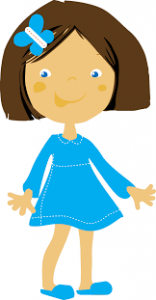

el libro los libros la niña las niñas
B. Indefinitive
Spanish has four forms equivalent to the English indefinite article A, AN, and SOME. They refer to unspecified persons, places, and things.
| SINGULAR | PLURAL | |
| MASCULINE | un | unos |
|---|---|---|
| FEMININE | una | unas |
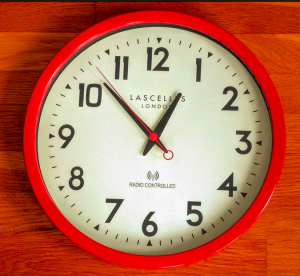


un reloj unos relojes
C. The expression HAY can express both “THERE IS” and “THERE ARE.” Use ¿HAY…? To ask: Is there…? Or Are there…?. Use NO HAY to express “There is not…” or “there are not…” HAY is always used with un, uno, una, unas.
Ejemplos:
En la clase Hay una profesora. There is one teacher in the class.
Hay un escritorio en la clase. There is one desk in the class.
Spanish Indefinite Articles
1.2 Gramática: Nouns-Gender and Number
A. GENDER: all nouns in Spanish are either masculine or feminine. Since English doesn´t have gendered nouns, it is easy to underestimate the importance of this concept in Spanish. When learning new nouns, always practice them with their gender.
| MASCULINE NOUNS | FEMININE NOUNS |
|---|---|
| 1. Most nouns ending in –o are masculine.
el libro, el carro, el escritorio 2. Nouns that end in a consonant el lápiz, el reloj, el ordenador 3. Nouns that end in -ma and -pa AND are cognates** el problema, el sistema, el programa, el fantasma, el mapa 4. Nouns that end in -e* el ambiente, el timbre, el estante
*There are some exceptions with this group: Common feminine exceptions: la clase, la noche, la tarde **Cognates are words that look alike, sound alike, and mean alike in both languages. Exception: LA mano |
1. Most nouns ending in –a are feminine.
la casa, la mesa, la computadora 2. Nouns that end in –ión (the English equivalent is “tion”) la televisión, la comunicación, la educación, la situación 3. Nouns that end in -ad (the English equivalent is “ty”) la universidad, la humanidad, la comunidad, la libertad
Exception: EL día
|
Certain nouns clearly denote a male or a female.
| MASCULINO | FEMENINO |
| el señor, el hombre, el chico, el estudiante, el perro, el gato | la señora, la mujer, la chica, la estudiante, la perra*, la gata*
*People who know that their pet is female will use the feminine form. If the sex of a pet or animal is unknown, the masculine form is typically used. |
|---|
ACTIVIDAD #1
En la clase. Work with a partner to guess the gender (el or la) of the following words. Be prepared to share with the class and discuss the meaning of each word.

| Article | Nouns |
Meaning |
|---|---|---|
| bolígrafo | ||
| cuaderno | ||
| lección | ||
| lápiz | ||
| pluma | ||
| mapa | ||
| marcador | ||
| pizarra | ||
| reloj | ||
| silla | ||
| celular (móvil) |
||
| mesa | ||
| borrador | ||
| destacador |
ACTIVIDAD #2
Write the appropriate definite article for each noun in the first column and an indefinite article for each noun in the second column.
¿el, la, los, las? ¿un, una, unos, unas?
____ señora ____ poema ____ libro ____ computadoras
____ cuadro ____ paredes ____ pluma ____ ciudad
____ lección ____ fotos ____ mapa ____ composición
____ clase ____ universidad ____ cuadernos ____ reloj
¡Inténtalo!
ACTIVIDAD #3
Oraciones. Form a sentence using HAY, the given words, and the correct article. Follow the example.
Ejemplo: Profesora / clase Hay una profesora en la clase.
- Estudiantes / universidad
- Libros / mesa
- Cuadernos / silla
- Diccionarios / biblioteca
- Señora / casa
- Chico / clase
- Bolígrafos / mochila
Transgender and non-binary individuals
| For individuals who identify as male or female, always use the grammatical gender that corresponds to a person´s identity. To ask someone what their pronoun is, ask: “¿Cuál es su pronombre?” To respond, answer: “Mi pronombre es ____.” Fill in the blank with él (he), ella (she), or another pronoun such as elle (non-gendered, singular). Non-binary pronouns such as elle are newly emergent and may not be widely used or understood.
Spanish, as a highly gendered language, has not yet adapted systematically to account for non-binary identities. There is a movement to use terms such Latinx, although the “x” is not currently used in sentence structure and is not yet widely used outside of the United States. The use of -e endings instead of -o or -a endings or gendered nouns, articles, and adjectives has also emerged from Spanish-speaking communities. While there is currently no unanimously accepted solution for approaching gender agreement for non-binary individuals, language evolves alongside the communities that use it to express their life experiences, and this is an ongoing conversation. If you are non-binary, you may choose to initiate a discussion with your instructor to discuss ways that you can use the language to describe yourself best. GROUPS Groups are only feminine when every member of the group is female. If one male is present, groups will be identified as masculine.
Adapted from: Libro Libre: Beginning Spanish CC BY-NC-SA 4.0
|
|---|
Gramática: Nouns- Gender and Number
B. NUMBER (Singular and Plural)
If a word ends in a vowel (a, e, i, o, u), add -s If a word ends in a consonant, add –es
| SINGULAR | PLURAL |
| el reloj
el carro la silla la canción |
los relojes
los carros las sillas las canciones (it loses the accent) |
|---|
When a word ends in –Z, change the –z by –c and add –es.
| SINGULAR | PLURAL |
|---|---|
| el lápiz
la luz el pez |
los lápices
las luces los peces |
*NOTAS:
1. The masculine form is used when the plural refers to two or more nouns
of different genders.
Ejemplo:



el niño + la niña = los niños
2. If a word has an accent on the final syllable, the accent goes away
when pluralized.
Ejemplo:
La comunicación becomes las comunicaciones
la lección becomes las lecciones
Making Nouns Plural
ACTIVIDAD #1
Cambiar. Change the following words to the corresponding plural.
- El señor
- El lápiz
- La lección
- La luz
- La mujer
- El libro
- La estudiante
ACTIVIDAD #2
¿un, una, unos, unas? Write the indefinite article and the corresponding noun. Pay attention! Some are plural.



1.______________ 2. _______________ 3. ________________




4. _____________ 5.________________ 6.__________________
ACTIVIDAD #3 ¿Qué hay en el escritorio?
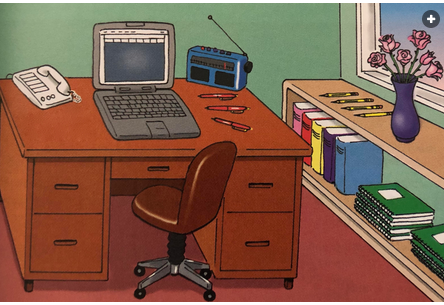
Fill in the correct indefinite articles [un, una, unos, unas] for the nouns in the picture.
Note: Hay = there is/there are
1. Hay____ teléfono en el escritorio.
2. Hay____ cuadernos en el estante.
3. Hay____ computadora en el escritorio.
4. Hay ____bolígrafos en el escritorio.
5. Hay ____escritorio.
6. Hay ____silla.
7. Hay____florero (vase).
8. Hay____ ventana (window).
¡Inténtalo!
ACTIVIDAD #4
¿Hay o no hay? Express in Spanish the following sentences.
- There are two teachers.
- There is a map.
- ¿Is there a class?
- There are some computers in the classroom.
- ¿Are there children in the classroom?
1.3 Gramática: Numbers 0-100
| 0 —cero
1 —uno 2 —dos 3 —tres 4 —cuatro 5 —cinco 6 —seis 7 —siete 8 —ocho 9 —nueve 10 –diez |
|---|
Eleven through fifteen are different
| 11 —once
12 —doce 13 —trece 14 —catorce 15 —quince |
|---|
Watch the pattern from 16-19: dieci + number
| 16 —dieciséis
17 —diecisiete 18 —dieciocho 19 —diecinueve |
|---|
The -e in veinte changes to an “i” when connecting a 1-9 number.
| 20 —veinte 25 —veinticinco
21 —veintiuno** 26 —veintiséis 22 —veintidós 27 —veintisiete 23 —veintitrés 28 —veintiocho 24 —veinticuatro 29 —veintinueve
|
|---|
| **UNO and all combinations (21=veintiuno, 31= treinta y uno, etc.) become UN before a masculine noun:
Ejemplo: Veintiún libros = twenty one books |
| Treinta y un libros = thirty one books |
From 30 to 99 things get easier: Thirty and one, thirty and two. . .thirty and nine. . .etc. This pattern continues until ninety and nine. However, when you pronounce them, it sounds like one word.
| 30 —treinta 40 —cuarenta
31 —treinta y uno** 50 —cincuenta 32 —treinta y dos 60 —sesenta 33 —treinta y tres 70 —setenta 34 —treinta y cuatro 80 —ochenta 35 —treinta y cinco 90 —noventa 36 —treinta y seis 100 —cien* 37 —treinta y siete 38 —treinta y ocho 39 —treinta y nueve *Cien works for 100 “on the dot” only. We will see larger numbers later, however, after 100 (101, 105, 120, etc), “hundred” becomes “ciento.” |
|---|
ACTIVIDAD # 1
Los números de teléfono. Phone numbers. In the Spanish-speaking world, a common way to say phone numbers is to state the first number as a SINGLE DIGIT, and then state three DOUBLE-DIGIT numbers for the rest.
Completar. Write down the following telephone numbers in Spanish:
Ejemplo: María: (480) 461-7859 4-80 4-61-78-59
cuatro-ochenta- cuatro-sesenta y uno-setenta y ocho-cincuenta y nueve.
1. Arturo: (480) 6-31-87-20
2. Pedro: (602) 7-40-21-18
3. Susana: (480) 9-12-56-67
4. Lalo: (602) 1-76-12-99
5. Ana: (923) 4-25-11-34
6. Mi número de teléfono es. . .
CUÁNTOS before masculine nouns and CUÁNTAS before feminine nouns are used to ask how many people or things there are.
Ejemplo:
¿Cuántos estudiantes hay en la clase? How many students are there in class?
Hay quince estudiantes. There are fifteen students.
¿Cuántas sillas hay en la clase? How many chairs are there in class?
Hay veinte sillas. There are twenty chairs.
ACTIVIDAD # 2
¿Cuántos hay? Look at the pictures and write how many people or things there are in the following drawings. Use HAY + number + noun






1._______________ 2.____________________ 3.________________ 4._________________
ACTIVIDAD # 3
ESCUCHAR. Los números. Write the number you hear.
Ejemplo:
a. 25__
b. _____
c. ____
d. ____
e.____
f. ____
¡Inténtalo!
Now, write out the numbers to check your work.
ACTIVIDAD # 4
Use the pictures to fill in the blanks with the correct number in Spanish. Spell the number. If you need a written accent copy the letter from here: á é í ó ú

1. Hay ____________estados (states) en Los Estados Unidos.
2. ______________ países (countries) hablan español.
3. Hay por lo general, ___________números en una tarjeta de crédito (credit card).
4. El inglés es el idioma (language) oficial en __________________ países.
5. La ONU reconoce (the UN recognizes) __________________países en el mundo en 2020.
¡Inténtalo!
ACTIVIDAD # 5
En la clase. With a partner, take turns asking and answering the following
questions.
Possible answers:
Hay ____________.
Sí hay ___________. No, no hay _____________.
- ¿Cuántos estudiantes hay en la clase?
- ¿Cuántos profesores hay en la clase?
- ¿Qué hay en tu (your) mochila?
- ¿Hay niños en la clase?
- ¿Cuántas mujeres hay?
- ¿Hay hombres?
- ¿Cuántas computadoras hay en la clase?
NOTE: In Spanish, we use the verb TENER to talk about age.
Ejemplo: ¿Cuántos años TIENES? How old are you?
TENGO dieciocho años. I am eighteen years old.
¿Cuántos años TIENE (usted)? How old are you?
TENGO cincuenta años. I am fifty years old.
1.4 Gramática: Present Tense of SER (be verb)
A. SUBJECT PRONOUNS (Los pronombres personales)
Before we start using verbs and constructing full sentences, we need to begin with personal pronouns which tell us WHO is doing the action in the sentence.
- Subject pronouns often replace a subject noun and can be classified in several different ways: by the person (first, second, or third person), number (singular or plural), gender (male or female), and formality (formal or informal).
- Subject pronouns can be used to replace a person’s name. However, many native speakers of Spanish rarely use them at all. This is because Spanish verb endings tell you who the subject is.
- The English pronoun IT is not expressed as a subject in Spanish.
Ejemplo: What is it? It is a book.
¿Qué es? Es un libro.
| SINGULAR | PLURAL |
| Yo (I) | Nosotros (We- all men, mixed group)
Nosotras (We-all women) |
|---|---|
| Tú (You, familiar/informal) | Vosotros (You all -Spain)
Vosotras (You all-Only women-Spain) |
| Usted (You, formal) | Ustedes (You all- Latin America) |
| Él (He) | Ellos (They-all men, mixed group) |
| Ella (She) | Ellas (They-all women) |
Video: Spanish Subject Pronouns
ACTIVIDAD # 1
Escribir. Replace the following people with the appropriate subject pronoun.
- El señor y la señora Rodríguez
- Mi amigo
- Mi mamá y yo
- Patricia y María
- Los estudiantes
¡Inténtalo!
ACTIVIDAD # 2
Seleccionar. Fill in the blanks with the subject pronoun you would use to address the following people and also when talking about them.
Ejemplo: Don Pedro
Addressing him: usted Talking about him: él
- Las niñas
Addressing them: ______ Talking about them: ______
- Mi profesor de español
Addressing him: _______ Talking about him: _______
- José y Carmen
Addressing them: ______ Talking about them: ______
- Mi hermana (my sister)
Addressing her: _______ Talking about her: _______
- La doctora García
Addressing her: _______ Talking about her: _______
1.4 Present tense of SER
B. THE VERB SER
The verb SER in Spanish means “To Be” and is used to talk about the following*:
| “POND” Mnemonic Devices are a great technique for language learning |
|---|
Profession
Origen (Ser followed by “de”)
Nationality
Descriptions ( Personality and Physical Characteristics)
*We will learn more uses for “Ser” in lesson 5.
Ser-To be
| Singular | Plural |
|---|---|
| Yo Soy
|
Nosotr@s Somos
We are |
| Tú Eres
You (informal) are |
Vosotr@s Sois
You all are (Spain) |
| Usted (Ud.) Él Es EllaYou (formal) are, he/she is, it is* one thing-it |
Ustedes (Uds.) Ellos Son Ellas You all are (Lat.Am.), they are*2 + things |
Ejemplos:
- Profession = Yo soy enfermero (I am a nurse)
- Origin = Marta es de Uruguay. (Marta is from Uruguay)
- Nationality = Mis padres son chilenos. (My parents are Chilean)
- Description = Mi hermano es alto y amable (My brother is tall and nice)

María es de Colombia. Ella es colombiana y es profesora de español.
Ella es responsable y muy independiente.
Los cognados
Note that many Spanish and English words are similar or identical in form and meaning. These words are called cognates. It is beneficial to start recognizing and utilizing cognates immediately. Here are some examples:
To describe people (using the verb SER)
cruel optimista elegante paciente idealista pesimista
importante responsable inteligente interesante terrible
tolerante sentimental independiente
ACTIVIDAD # 1
Seleccionar. Select the appropriate form of SER to complete the following sentences.
- Pedro (es, soy, somos) de México.
- Los estudiantes (somos, son, es) muy inteligentes.
- Mi mamá (son, eres, es) profesora de español.
- Shakira (es, son, eres) colombiana.
- ¿De dónde (son, es, eres) tú?
¡Inténtalo!
ACTIVITY # 2
Cambiar. Change the given sentences using the pronoun given and the appropriate conjugation of the verb SER.
Ejemplo: Nosotros somos profesores. Usted ES profesor.
1.Usted es de España. Ellos _____ ____ ________.
2.Nosotros somos estudiantes. Él ____ _______________.
3. Yo soy estudiante. Tú ________ _____________.
4. Ustedes son de México. Nosotros _______ ___ ______ .
5. Ella es enfermera. Yo ______ _____________ .
6. Tú eres de Ecuador. Ellas ______ ____ _________.
7. Ellos son americanos. Ustedes _____ ____________ .
ACTIVIDAD # 3
Descripciones. ¿Cómo eres? (¿Cómo es usted?). What are you like? Indicate all the appropriate words to describe yourself and others.
1. Yo soy. . . . .
______inteligente ______pesimista _______optimista
______ interesante ______ cruel _______tolerante
______terrible _______ impaciente _______?
2. Mi mejor amigo (a) (my best friend) es. . .
______inteligente ______pesimista _______optimista
______ interesante ______ cruel _______tolerante
______terrible _______ impaciente ______?
ACTIVITY # 4 Write-Share
El origen. Answer the questions below about where these people are from. Don´t forget to use “de” after SER when talking about origin.
- ¿De dónde eres?
- ¿De dónde es tu (your) mamá?
- ¿De dónde es tu papá?
- ¿De dónde son tus abuelos (grandparents)?
ACTIVITY # 5
¡Hablemos! With a partner, take turns asking and answering the following questions:
ESTUDIANTE A
- ¿De dónde eres?
- ¿Eres estudiante?
- Tus padres (parents) son estadounidenses?
- ¿Tu mamá es simpática (nice)?
- ¿Tu papá es doctor?
ESTUDIANTE B
- ¿De dónde eres?
- ¿Tu profesor (a) es de México?
- ¿Tu mejor amigo (a) (best friend) es inteligente?
- ¿Eres estudiante de portugués?
- ¿Tu papá es americano?
ACTIVITY # 6: Read-Write-Share
First, let’s meet the following people. Then, write information about yourself and share it with the class.
Hola, ¿Qué hay de nuevo? Me llamo Cristiano Ronaldo. Soy de Portugal y SOY futbolista profesional, ¡el mejor! (the best). ¡Chao!

¡Hola! Me llamo Shakira. SOY de Colombia. ¿Cuál es mi profesión? SOY cantante. ¡Hasta luego!

¿Qué tal, estudiantes de español? SOY Guillermo del Toro y SOY mexicano. SOY director de cine (film). Nos vemos en el capítulo 4.

![]() It is your turn now.
It is your turn now.
__________________________________________________
___________________________________________________
___________________________________________________.
Escritura: Composición 1- Información personal
Write a two-paragraph composition using the verb SER, and the vocabulary learned in lesson 1.
In the first paragraph, in Spanish, tell a little about yourself, including:
- name
- where you are from
- nationality
- age
- profession or occupation
- TWO descriptors (personality)
In a second paragraph, talk about a member of your family or a friend, using the same information above.
Ejemplo:
Información personal
Me llamo Rosalba y (and) soy de Chile. Soy chilena y soy profesora de español en MCC. Tengo 35 años. Soy generosa y muy (very) independiente.
Mi hermana (my sister) SE LLAMA yenni. Ella es de Chile también (also). Es chilena y es ama de casa (housewife). Ella tiene 30 años y es optimista y responsable.
**Note: use se llama + name to talk about someone else.
CULTURA: USA
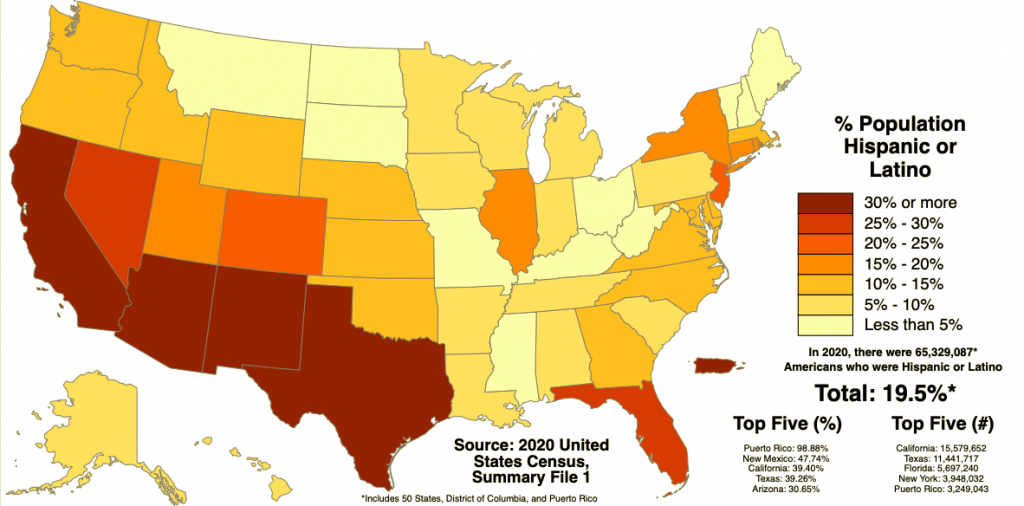
Spanish is the third most studied and spoken language in the world. In the United States of America alone, Spanish is spoken by approximately 41 million native speakers and almost 12 million bilingual speakers. There are more Spanish speakers in the United States than in Spain or Colombia. The majority of speakers are from Mexico, Puerto Rico, and Cuba. The Southwest concentrates the most Spanish speakers of Mexican origin, while New York and New Jersey have a large population of Puerto Rican descendants. In Florida, the largest community is of Cuban origin. Several other nationalities are also represented in these same areas.
Música: Selena
Selena Quintanilla (1971-1995) was an award-winning Latin recording artist, known as the ‘Queen of Tejano Music,’ a Mexican music style that mixes other genres like country.
Canción: Bidi Bidi Bom Bom
|
Do you want to learn more about Selena? Visit her page: http://www.selenaforever.com/ |
|
|---|
Personalidad: César Chávez
Press play to listen to the pronunciation of the reading in the paragraph written below.

César Chávez (1927-1993) nació (was born) en Yuma, Arizona.
Chávez es el fundador de la Unidad de los Trabajadores Agrícolas (United Farm Workers – UFW), sindicato (union) que busca mejorar las condiciones laborales de los jornaleros emigrantes, en su mayoría hispanos.
Mediante (through) marchas, huelgas (strikes) y boicots, se obliga a los patrones a pagar salarios mejores y otros beneficios.
En 1970 César Chávez y Dolores Huerta (co-founders of UFW) adoptaron la frase “Sí se puede” durante 25 días de ayuna (25-day fast) en Phoenix, Arizona. (to organize farm workers to demand fair wages and better working conditions.
Preguntas de Comprensión. After reading the short biography of César Chávez, check if the following statements are Verdadero (V) or Falso (F)
- César Chávez es de California. V F
- Chávez es el fundador de la UFW. V F
- César Chávez busca mejorar las condiciones de los trabajadores (workers) V F
- Chávez usa la frase ¨Sí se puede¨ para inspirar a los trabajadores. V F
¡Inténtalo!
 Lectura: Saludos en los países hispanos
Lectura: Saludos en los países hispanos
It is always nice to meet up with a friend. You can walk up to them, say hello, give them a high-five, and ask them, “What’s up?” Sounds easy enough. But what if that friend of yours lives in Mexico or South America, or is originally from there? Should you shake hands, give them a kiss (or maybe two), wave, or give them the old high-five? The truth is, greetings in other cultures can be very different. This is especially true in Latin American culture, and if you aren’t prepared, you can find yourself in some very awkward and strange situations. In Latin America, the way people greet each other can vary from region to region, but here are some basic tips to help you in most instances.
- Relatives and Friends – In general, friends and relatives in Latin America greet each other with a kiss or a hug. When a male greets a female or a female greets another female, here is what happens: they will gently touch both arms and move together until they are about six inches apart. Then they cock their heads, put their cheeks together, and make a light kissing sound. When a male greets another male, who is his relative or friend, it is customary for them just to approach each other and give each other a hug.
- Casual Parties – When you are invited to someone’s home, you can generally expect to be treated like a friend or relative. Be prepared for a kiss or a hug! If you are unsure about what to do when you are in someone’s home, the best thing to do is follow the lead of your host. You can observe their body language and simply follow their lead. In some countries and regions, you may also be kissed twice – once on one cheek and once on the other cheek. If you are prepared to follow the lead of your host, you’ll do just fine!
- Business – In most business situations and greetings, you can generally expect to shake hands, unless you are a long-time acquaintance or relative. In this case, follow the “Relatives and Friends” guideline, but again, be sure to follow their lead.
ACTIVIDAD # 1
Answer the following questions based on the reading:
1. Describe how a male greets a female or a female greets another female in most Latin American countries.
2. What is the most appropriate greeting to use when you are invited to someone’s home?
3. What is the most common greeting in a business setting?
4. How do you greet your friends and relatives?
ACTIVIDAD # 2
Saludos. Role-play the following greetings with a partner. Include a verbal and non-verbal greeting, as appropriate.
1. Friends in Costa Rica
2. Business associates at a conference in Colombia
3. Relatives in México
4. Friends meeting in a restaurant
5. Meeting the hostess at a party 


